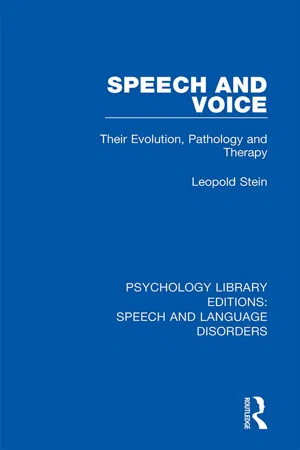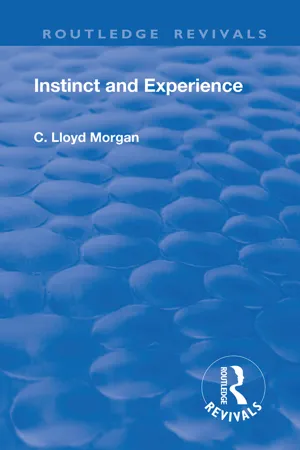Biological Sciences
Reflexes
Reflexes are automatic, involuntary responses to stimuli that help protect the body from harm. They are controlled by the nervous system and occur without conscious thought. Examples of reflexes include the knee-jerk reflex and the withdrawal reflex when touching something hot.
Written by Perlego with AI-assistance
Related key terms
5 Key excerpts on "Reflexes"
- eBook - ePub
Speech and Voice
Their Evolution, Pathology and Therapy
- Leopold Stein(Author)
- 2018(Publication Date)
- Routledge(Publisher)
From this we infer that it is based on that evolutionary pattern. Such reflex actions, as far as they are “inherited habits, characterised by a high degree of sensitisation in their nerve-circuits, as evidenced by the promptitude and invariability of the response,” are termed instincts. 1 Sympathetic nervous system. —Our description of the symptoms was not quite exact. We might have noticed that (5) the man became pale, that his pupils had dilated, and that his pulse had quickened; (6) on being questioned he would declare that he had heart palpitation and other vague bodily feelings of uneasiness, even that he was on the point of fainting. But his report seems to indicate that there is more in this than meets the eye. ‘Life’ itself was in danger. To maintain the life of a more specialised and differentiated organism organs have been developed—such as the intestines, heart, blood vessels, lungs, and glands—designed to effect metabolism. Their functions are controlled from a nerve-system constituting the oldest nerve-paths, viz. the sympathetic or autonomic nervous system. The autonomic nerves interact with the spinal nerves on the reflex principle already mentioned. In our example we saw how they unite in action to re-establish equilibrium. The processes going on in the sympathetic nervous system are highly canalised, and therefore hardly under our conscious control. This absence of conscious control is characteristic of reflex actions, instincts, and emotions. Endocrine system. —In recalling instances of blushing, feeble pulse, sweating, etc., which have occurred in other subjects under observation, we may assume that these primitive reflex processes are governed by some as yet undiscovered influences. In fact they encroach upon the primary factors of life, viz - eBook - ePub
- R. Michael Akers, D. Michael Denbow(Authors)
- 2013(Publication Date)
- Wiley-Blackwell(Publisher)
Fig. 10.14. Reflex arch. A reflex arch includes a sensory apparatus, a sensory neuron, a site of information processing or integration , and an effector. The sensory apparatus detects a change that is transmitted via the sensory neuron to the central nervous system. There, the information is processed and a motor response is sent via a motor neuron to the periphery in order to maintain homeostasis.Fig. 10.15.Monosynaptic and polysynaptic Reflexes. 1. In monosynaptic Reflexes, the sensory neuron is activated and carries a signal to the central nervous system where it synapses on an effector neuron. The effector neuron is activated causing an effect to occur in the periphery. 2. In a polysynaptic reflex, the sensory signal synapses on an interneuron in the central nervous system. The interneurons process the information and then synapse on an effector neuron. The interneurons can either be excitatory, causing activation of the effector neuron, or they can be inhibitory, thus decreasing the firing rate in the effector neuron.Classification of Reflexes
Reflexes can be classified based on their development, site of information processing, or resulting motor response.Development of reflex
Animals are born with some Reflexes called innate Reflexes . Such Reflexes involve the development of a genetically programmed response to specific stimuli. Such Reflexes generally entail some process vital for life. Examples of such Reflexes include suckling, chewing, a withdrawal reflex from painful stimuli, and tracking objects with the eyes. A newborn calf will generally begin suckling almost immediately after birth.Other Reflexes may develop later in life as a result of experience, and are called acquired Reflexes - eBook - ePub
- C. Lloyd Morgan(Author)
- 2018(Publication Date)
- Routledge(Publisher)
My summary account of reflex phenomena is based on Dr. C. S. Sherrington's admirable work. 1 I shall adopt his terminology and in stating some of his conclusions shall often use his own words. The simplest reflex involves three distinguishable but related processes; initiation by a stimulus, conduction, and end-effect; and for these three processes there are three separable structures, the receptor for the initiation, the effector for the end-effect, and, between these two, the conductor. Now such processes occur in the unicellular organisms; but, in them, separable structures are not clearly differentiated. Whether it is desirable to apply the term "reflex" to the behaviour of protozoa we need not here discuss. Dr. Sherrington thinks it better to reserve the term for reactions involving specifically recognizable nerve-processes, and morphologically differentiated nerve-cells—involving, that is to say, a reflex-arc, with receptor, conductor, and effector. The reflex therefore implies the existence of organic processes within the constituent structural cells; and it suggests, if it does not necessarily imply, the existence of physiological processes in the organic substance which intervenes between the cells. Such a simple reflex is then, for physiological interpretation the unit reaction in nervous integration. The idea we form of a simple reflex is, however, an abstract and analytic conception; because all parts of the nervous system are connected together and probably no part of it is ever capable of reaction without affecting and being affected by various other parts. In any case it only exhibits in ideal simplicity the first grade of co-ordination. It is obvious that if the integration of the animal mechanism is due to co-ordination by reflex action, Reflexes must themselves be co-ordinated with one another; for the co-ordination by reflex action there must be coordination of reflex actions. This is the second grade of co-ordination - eBook - ePub
A History of the Brain
From Stone Age surgery to modern neuroscience
- Andrew P. Wickens(Author)
- 2014(Publication Date)
- Psychology Press(Publisher)
8 THE RETURN OF THE REFLEX The initial cause of any human action lies outside the person. Ivan Mikhailovich Sechenov The brain is waking and with it the mind is returning. It is as if the Milky Way entered upon some cosmic dance. Swiftly the head mass becomes an enchanted loom where millions of flashing shuttles weave a dissolving pattern. . . a shifting harmony of subpatterns. Charles S. Sherrington Summary The concept of a reflex, or an involuntary physiological response produced by an external stimulus, was first illustrated in L’Homme by Descartes in 1662. It was a pivotal movement in the history of physiology where the flesh and bone of bodily movement previously accountable in terms of a soul-like animating force, now became explainable through mechanics. Despite this, the concept of a reflex was slow to develop in the century after Descartes because vitalist beliefs were not so easily dismissed. This is seen, for example, in the work of the eighteenth century physiologist Robert Whytt who highlighted the importance of nerve pathways for certain types of reflexive movement, yet continued to insist on a spiritual force (or ‘sentient principle’) to explain the body’s action. A more modern understanding of the reflex would have to wait until the anatomy of the spinal cord was better understood, and this advance took place through the endeavours of Charles Bell and Francois Magendie in the early part of the nineteenth century. Although the priority for their discoveries was disputed, the two men identified separate spinal pathways for the transmission of sensory and motor information. This would help enable the English physiologist Marshall Hall to elucidate the spinal and medullary mechanisms of a large range of complex reflexive behaviours, which he believed was free of any vitalist force - eBook - ePub
Exercise Physiology
for Health and Sports Performance
- Nick Draper(Author)
- 2014(Publication Date)
- Routledge(Publisher)
The nervous system is comprised of the brain, spinal cord, ganglia, nerves and sensory receptors. Despite its importance to the body, the nervous system comprises less than 5% of total body mass, with a mass of around 2 kg. The nervous system plays multiple roles during sports performance, including the initiation of muscular contractions that bring about movement. It is through the nervous system that we are able to respond to the ever-changing environment of the sports field, for example, a defender coming in to make a tackle, a tennis ball lobbed over your head, maintaining balance on a gymnastics beam. In a movement response, such as the start of a 100 m sprint race, nerve impulses from the brain or spinal cord link with the effector organ (muscle fibres) at neuromuscular junctions where the nervous stimulation is passed to the muscle fibre to initiate contraction of that fibre. This movement response is the result of three overlapping functions of the nervous system:- Sensory input – the information collected via sensory receptors which allows the nervous system to monitor changes both within, and outside, the body (e.g. the BANG of the starter’s gun).
- Integration – the method of processing and interpreting the sensory input and deciding on the appropriate course of action.
- Motor output – the response initiated by the nervous system by activation of the effector organs (muscles and glands) (e.g. the sudden, explosive push off the starter blocks).
Key point
The nervous system comprises less than 5% of total body mass but is vital to human functioning. The sensory, integratory and motor elements within the nervous system detect a stimulus, organise information and effect a response.Divisions of the nervous system
The nervous system is divided into two main divisions, the central nervous system (CNS) and the peripheral nervous system (PNS). The CNS includes the brain and spinal cord and is responsible for interpreting the sensory input and dictating the motor response. The PNS is the part of the nervous system outside the CNS and consists of peripheral nerves (12 pairs of cranial nerves, 31 pairs of spinal nerves), sensory receptors and ganglia. These nerves serve as the communication network between all parts of the body and the CNS. The PNS is further subdivided into the afferent (sensory) and efferent (motor) divisions. All divisions of the nervous system are illustrated in Figure 4.1
Learn about this page
Index pages curate the most relevant extracts from our library of academic textbooks. They’ve been created using an in-house natural language model (NLM), each adding context and meaning to key research topics.




